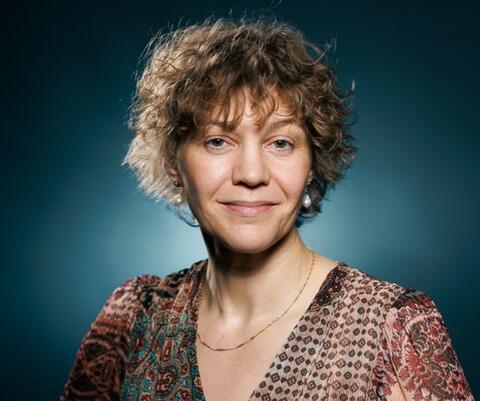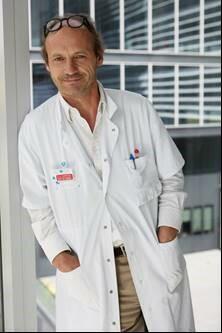
Gaëlle Bruneteau
Neurologist and principal investigator in the SONOSLA project to “open the blood barrier to treat Charcot disease” supported by MSDAvenir
The success of this study could open up new treatment prospects for ALS, offering the possibility of improved drug delivery to the nervous system.
Professor Gaëlle Bruneteau is a neurologist specializing in amyotrophic lateral sclerosis (ALS). She is the principal investigator in the MSDAvenir-supported project “Opening the blood barrier to treat Charcot disease”, led by Professor Alexandre Carpentier, head of neurosurgery and clinical neuroscience researcher.
While the tightness of the brain's vessels complicates the administration of drugs for the treatment of diseases of the central nervous system, Professor Carpentier developed in 2012 a device to temporarily permeabilize the blood-brain barrier by emitting low-intensity pulsed ultrasound for 4 minutes.
1) Can you first introduce yourself and tell us about your background?
I am a neurologist and I completed my entire neurology internship in Paris. During this period, I had the opportunity to do an internship at the reference center for amyotrophic lateral sclerosis (ALS). At that time, the expert center at Pitié Salpêtrière was headed by Professor Meininger. My main goal was to better understand this disease, which is rarely covered during medical studies. This experience marked the beginning of my commitment to this field, and I have never really left this path.
After completing my internship, I was reinstated as a clinical head, still within Professor Meininger's team. At that time, ALS was still largely unknown and there was a critical need for clinical research. It was this aspect that drew my interest and I was quickly involved as an investigator on therapeutic research protocols. Professor Meininger, as co-discoverer of Riluzole, the only treatment approved in France for ALS, embodied our team's commitment to clinical research from the beginning.
Over time, I had the opportunity to develop my own research projects on the pathophysiology of the disease before focusing on therapeutic research, an approach that is in line with our current efforts.
Currently, I work as a neurologist at the expert center for Charcot disease, within the neurology department of the Pitié Salpêtrière. At the same time, I coordinate a national clinical research network on ALS within the F-CRIN structure, a French initiative aimed at promoting therapeutic clinical research on the national territory.
2) Could you explain what is Charcot's disease?
Amyotrophic lateral sclerosis (ALS) is a disease classified as a neurodegenerative disease, affecting motor neurons, the neurons specialized in controlling muscles, present in the brain and spinal cord. In most cases, the disease is said to be sporadic, which means that it has no genetic cause and is not transmissible from generation to generation, but its cause remains unknown.
This lack of understanding of the underlying mechanisms of the disease constitutes a major challenge for the development of effective treatments. It is likely that ALS is in reality not a disease but a syndrome, with distinct pathophysiological mechanisms depending on the clinical forms. Therefore, it is crucial to conduct pathophysiological research to better understand these mechanisms, as this constitutes the basis for the development of new treatments. Identifying the mechanisms involved at the neuronal level is essential to be able to target them therapeutically. There is a huge need to develop therapeutic research and this is what we are trying to organize with the ACT4ALS-MND network, which provides valuable methodological and operational support. This network also offers essential support for funding applications, particularly in the context of projects such as the Hospital Clinical Research Program (PHRC).
3) Could you describe to us what your work is in the context of this research project and what are the main issues?
As a coordinating investigator, I am responsible for the therapeutic research protocol, so I am responsible for ensuring methodological compliance and the conduct of the study. This involves ensuring that the study scrupulously follows the established protocol and that it is carried out in compliance with good clinical practices, a set of global standards aimed at guaranteeing the safety and freedom of participants. The protocols are extremely detailed at each stage to ensure patient safety and provide precise answers to the questions asked.
Furthermore, my involvement in this project focuses mainly on clinical research and the specificity of ALS. While the SonoCloud device (a medical device that emits pulsed ultrasound to temporarily open the blood-brain barrier of the brain) has already been successfully tested in the treatment of brain tumors. Its application in the field of ALS will represent a world first. This initiative, although part of a single project, complements our global vision of research and treatment in this field.
4) What are the goals you hope to achieve at the end of this project?
The first phase of our study, involving 12 patients, aims to evaluate as a priority the safety of this new device for opening the blood-brain barrier, which normally seals the brain and spinal cord from the blood circulation and the rest of the body. As mentioned previously, this study represents a world first in the context of ALS, and although reassuring elements have been observed in the field of brain tumors, it is imperative to confirm the safety of the device in this particularly fragile population.
The second phase, made possible by the support of MSDAvenir, will consist of expanding the recruitment of our study. Rather than limiting ourselves to a simple safety assessment (phase 1), we plan to include 11 additional patients, which will allow us to move to a phase 2a, which will aim to identify the first potential signals of the efficacy of the device in slowing the deterioration of motor function associated with ALS.
Currently, no curative treatment is available for this disease. Riluzole, the only drug currently authorized for marketing in France for ALS, has a modest effect on patient survival, with no demonstrated effect on motor function to slow the spread of paralysis. We are therefore seeking to assess whether our device can influence these parameters. We will also use a promising blood biomarker, the neurofilament light chain level, to assess disease activity and its risk of future progression. A decrease in this level could indicate a reduction in neurodegeneration, which would be predictive of the effectiveness of the treatment. This is why this biomarker will be used as the primary endpoint for the second part of the study and its assessment will be done by simple blood test.
5) Do you think that we will one day be able to discover the causes of this neurodegenerative disease?
It is very likely that ALS is not a single disease, but rather a cluster of diseases. About 10% of ALS cases are genetic in origin, where a specific pathogenic mutation is responsible for the death of motor neurons. However, for the vast majority of patients, about 90%, the cause of the disease remains unknown and may even be different between patients. It is likely that ALS is the result of the complex interaction between a particular genetic background and environmental factors.
This diversity of contributing factors is reflected in the variability of symptoms and disease progression. For example, ALS may initially affect speech and swallowing in some patients, while in others it may begin with difficulty walking. In addition, disease progression can vary considerably from patient to patient, even in the absence of treatment.
It is also likely that these different manifestations of ALS are influenced by distinct biological mechanisms at the motor neuron level. Therefore, rather than searching for a single cause of the disease, it is essential to advance our understanding of the underlying pathophysiological mechanisms. This would allow us to better characterize patient populations according to their clinical course and specific biological mechanisms, which is crucial for the development of targeted treatments.
6) MSDAvenir supports the SONOSLA project. What does this support mean for your project?
First of all, we express our gratitude to MSDAvenir for its trust and support for this project. Professor Carpentier's team is recognized for its expertise in the therapeutic strategy of brain tumors, but this approach is entirely new in the context of ALS. Without the support of MSDAvenir, we would not be able to conduct such a comprehensive study to evaluate both the safety of the device and to look for first signals of efficacy. We would have been forced to limit the duration of the study and the number of participants. This larger and more ambitious study could truly transform the management of the disease, both in terms of safety and efficacy.
In the absence of efficacy signals, but with confirmation of the safety of the device, this would nevertheless constitute an important first step for the development of new therapies. One of the main challenges in developing treatments for diseases of the nervous system, including ALS, is to enable drugs to reach their target in the nervous system.
Most drugs administered orally or by infusion have limited penetration into the nervous system, which reduces their effectiveness. The success of this study could open new treatment perspectives for ALS, by offering the possibility of improving the delivery of drugs into the nervous system. Thus, this protocol offers three perspectives: first, to evaluate the safety of use of the device, then to identify possible first signals of efficacy by modulating neuroinflammation, one of the mechanisms involved in the death of motor neurons. This protocol will also lay the foundations for its association with other drugs, thus improving their effectiveness in the treatment of ALS.
By Chaineze Moussaid
Support our healthcare projects
Contribute to the advancement of scientific research in the field of health.
Alexandre Carpentier
Head of neurosurgery and SonoSLA project leader
We pursue our research with enthusiasm, hoping to offer new therapeutic perspectives to those who need them most.

